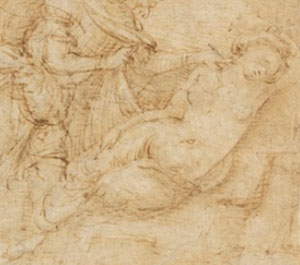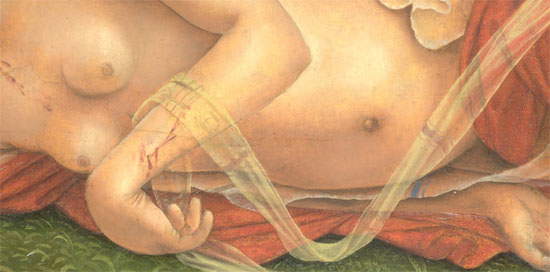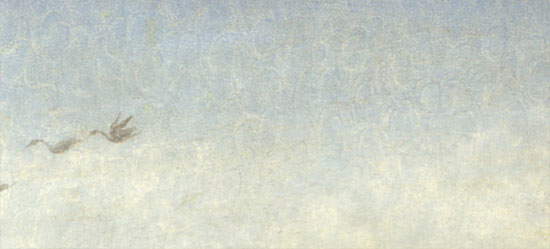Any art history textbook in which the figure of Piero di Cosimo (1462 - 1522) is outlined certainly does not discount his eccentric and, as Federico Zeri had to add, unconventional nature: they all report the oddities and quirks of his character. However, lingering in front of certain of his paintings, one almost forgets what one has learned from the textbooks: we witness a vivid contrast between the harshness of the artist’s temperament and the incredible refinement of certain figures combined with theelegance of many compositions. And, in this sense, one of the peaks of Piero’s poetics is a painting currently preserved at the National Gallery in London, and visible to the Italian public again for one last weekend during the exhibition Piero di Cosimo. Eccentric Painter between Renaissance and Mannerism at the Uffizi Gallery.
It is a work of rare beauty, it is anelegy that takes the form of a panel and is translated into color, it is a melancholy lyric that becomes oil painting. The painting depicts a slain nymph being planted by a satyr, above a meadow described with the botanical meticulousness typical of 15th-century Florentine painters. That the death is not natural is shown to us by the cut on the neck, from which blood still gushes, a sign that the killing occurred recently. We are used to imagining satyrs, beastly half-man, half-goat creatures, always prey to their unhealthy feral impulses. But this represents one of the rare exceptions: it is one of the most humane satyrs in all of art history. In fact: he is perhaps the most human. His sadness is alive, it is palpable: not only because of his disconsolate gaze, because of that typical expression of a person who seems about to burst into tears at any moment. Also, and perhaps above all, by his gestures: with his left hand he touches the nymph by the shoulder, in order to see her better. Or perhaps to wake her up, as if not wanting to come to terms with the loss. With the other, he gently moves her bangs to uncover her face: we perceive all the levity of this last caress that the satyr wants to make, desolate, to the nymph. This gesture, more eloquent than a book, would be enough to communicate to us the sadness of the moment.
 |
| Piero di Cosimo, Satyr Mourning the Death of a Nymph (c. 1495-1500; London, National Gallery) |
But Piero di Cosimo wants all of nature to share in the poor nymph’s sad fate. Here, then, is the dog that appears on the right with a dejected look and bowed head: the animal thus demonstrates its feelings. And the same thing applies to the dogs that stand in the background. As well as for the birds: the pelican symbolizes sacrifice, because in ancient times these birds were believed to tear open their breasts to feed their young, while the herons we see in flight are symbolic of weeping, because according to a passage in Pliny the Elder’s Naturalis historia, herons are said to be wont to weep tears of blood(mares quidem cum vociferatu sanguinem etiam ex oculis profundunt, “the males, screaming, also weep blood from their eyes”: the assertion is not scientifically founded, however).
 |
| Piero di Cosimo (attributed to), Dream of a Warrior, detail of the reclining female figure (c. 1495-1500; Florence, Uffizi Gallery, Cabinet of Drawings and Prints; inv. 1257 E) |
 |
| Piero di Cosimo (attributed to), Woman Lying in a Landscape and Two Nude Figures (c. 1495-1500; London, British Museum; inv. 1902,0822.6) |
 |
| Detail of the nymph’s body |
 |
| The sky in the painting, with the painter’s fingerprints |
At this point, the question the reader will surely ask is this: what is the significance to be attributed to this painting? Until not so long ago, art historians were all but unanimous in identifying this scene as the story of Cephalus and Procri, told in Ovid’s Metamorphoses. Cephalus was a beautiful young man, married to Procri: however, Eos, goddess of the dawn, fell in love with him and wanted him at all costs. For this reason, she decided to instill in Cephalus the doubt that Procri was cheating on him, and the young man, urged on by the goddess, set up a ruse to prove his wife’s infidelity. The test was successful, and the wife fled in shame: however, Procri managed to receive as a gift from the goddess Artemis an infallible javelin and a dog capable of catching any prey, in order to make a gift of it to Cephalus in hopes of winning back his heart. Cephalus agreed and the two made peace, but during a hunting trip Procri, still not quite convinced that Cephalus was not in love with Eos, hid behind a bush in order to have, too, proof of her husband’s possible betrayal. Cephalus, however, mistook Procri for prey, threw the javelin at her, and killed her by mistake, to her utter despair.
Here: this was thought to be the myth depicted by Piero di Cosimo’s painting. There are, however, several inconsistencies. Although the dog is present, the javelin is missing, the fronds behind which Procri is said to have hidden and which are part of the iconographic tradition of the story are missing, and of course Cephalus, who was not a satyr but a handsome man, is missing. However, the faun is present in the Fabula di Cefalo, a play by Niccolò da Correggio, which reworks the Ovidian myth (adding, moreover, a happy ending) and was performed on January 21, 1487, at the court of Ferrara in honor of the wedding between Lucrezia d’Este, daughter of the Duke of Ferrara Ercole I, and Annibale II Bentivoglio, son of the lord of Bologna, Giovanni II. However, the hypothesis of identifying the Fabula of Cephalus as the source Piero di Cosimo drew on for his table has appeared weak to some: the only link would be the figure of the faun, because we do not know if Piero really knew the work, nor do we know of any relations he might have had with the Ferrara milieu. Although, in any case, the text of Niccolò da Correggio’s work does not say to whom we owe the discovery of Procri’s body, which Piero would seem to attribute to the faun. In short, shaky or not, such connections were deemed sufficient to identify the affair: at least until 1951, when, for the first time, art historian Martin Davies, compiling a catalog of paintings of the Italian schools in the National Gallery, rejected the traditional identification of the painted subjects as the protagonists of the Cephalus and Procri myth. An alternative identification, however, would not have been proposed, but these days not a few prefer the painting to be shrouded in this halo of uncertainty: so much so that the exhibition on Piero di Cosimo at the Uffizi presented the painting precisely under the title of Satyr Mourning the Death of a Nymph.
Given the format of the panel, and given the alleged episode narrated (which could have represented a sort of invitation to fidelity for two young newlyweds), art historians have always considered the work a probable wedding gift. On the back of the painting appears the coat of arms of the noble Guicciardini family, one of the most important in Florence. This is a coat of arms affixed at a later time than when the work was created, which nonetheless testifies to the fact that, before passing to the National Gallery in 1862, the work was part of the Guicciardini’s collections. It has therefore been speculated that the work may have been produced on the very occasion of the marriage of one of the family members, perhaps as a decoration for an espalier, but the original history of the painting remains unknown to this day, and we can only move in the realm of hypothesis.
Here, what is known, well-known and illustrious is only the extraordinary elegance of one of the most fascinating painters in the history of art, whose modernity and refinement have perhaps been overshadowed by Vasari’s accounts about his wit being “so abstract and dissimilar” to those that virtue creates “beautiful.” But, as we said above, when one encounters a painter who loved nature to such an extent that it participated with force and transport in a tragic event, one can only reflect on Piero di Cosimo’s great sensitivity and his ability to create true poems with fingers and brushes.
Warning: the translation into English of the original Italian article was created using automatic tools. We undertake to review all articles, but we do not guarantee the total absence of inaccuracies in the translation due to the program. You can find the original by clicking on the ITA button. If you find any mistake,please contact us.